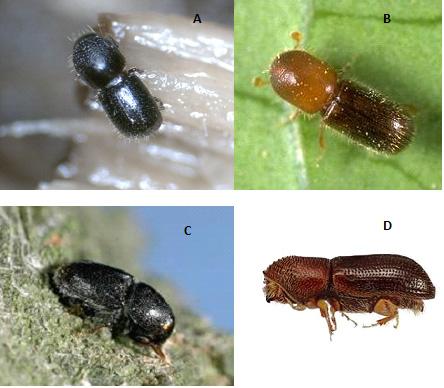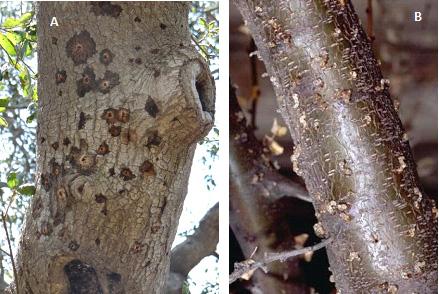Spring 2014: Polyphagous shot hole borer look-alikes
Regional Report for Ventura County by Jim Downer
As we continue an historic drought in California, trees all over Southern California are showing symptoms of stress. Drought predisposes trees to pests and diseases, and in some cases, these trees have died. Drought-stressed trees in landscaped and naturally vegetated areas of nurseries can serve as host reservoirs, increasing pest problems in plant production areas and increasing the spread of invasive pests on nursery plants. Trees and other woody plants in nurseries also bear the burden of extra drought stress as irrigation waters become increasingly saline due to drought effects on water supplies.
The polyphagous shot hole borer (PSHB [fig. 1 A]), as described elsewhere in this newsletter, is a serious pest of nursery and landscape trees that threatens many species. Counties adjacent to Los Angeles are at high risk for invasion of PSHB. The drought has stressed many of the reproductive host trees that could be attacked by PSHB. Trees are also often attacked by other native or established beetle pests. In some cases, these beetle pest species closely resemble PSHB and may cause similar symptoms, such as bleeding, cambial discoloration and gallery formation. 
Fig. 1. PSHB (A), western oak bark beetle (B), shothole borer (C), walnut twig borer (D). Photos by A. Eskalen (A); JK Clark (B,C); S. Valley, Oregon Dept. of Agriculture, Courtesy of UCIPM: “Detecting and Identifying the Walnut Twig Beetle” (D).
On coast live oak (Quercus agrifolia), there are two beetles that resemble PSHB: the western oak bark beetle (Pseudopityophthorus pubipenis [fig. 1B]) and the oak ambrosia beetle (Monarthrum scutellare). The western oak bark beetle is common in Southern California while the ambrosia beetle is more common in the northern half of the state, but both have been detected throughout California. As with many beetle/tree interactions, both of these insects are especially attracted to drought-stressed trees. When attacked, coast live oak bleeds heavily and since these insects often attack in larger numbers, there is a uniform pattern of bleeding along the main branch stems or trunk. The cambium of oak bark beetle attacked trees often reveals small galleries and little or no necrotic tissue.
Prunus spp. such as peach, nectarine, plum and apricot are common in back yards and nurseries. This year we are seeing increased attack of Prunus by the shothole borer or fruittree bark beetle (Scolytus rugulosus [fig. 1C]), a beetle very similar in stature to PSHB. The insect is the same size as PSHB and makes numerous holes which causes excessive bleeding in Prunus (see Fig. 2 A,B for tree damage caused by PSHB and by shothole borer). Fungi may gain entrance through the beetle’s entrance and exit holes and eventually girdle limbs, which may result in branch or tree death.
Fig. 2. Sap bleeding and staining symptoms caused by PSHB on coast live oak (A) and gumming in response to wounding by the shothole borer on Prunus (B). Photos by A. Eskalen (A) and JK Clark (B).
Another insect that could be mistaken for PSHB is the walnut twig borer (fig. 1 D), which vectors thousand cankers disease of walnuts (both native and English). This beetle (Pityophthorus juglandis) carries with it a fungus, Geosmithia morbida, that causes extensive cambial necrosis, and ultimately twig and branch dieback results from its presence.
These four look-alike beetles are all small, with similar diameter bore holes; all cause host bleeding and destroy the vascular cambium when they attack en masse. Also of note is that the host range of the look-alike insects is much narrower than that of PSHB. So when examining oak, Prunus, or walnut, these insects should be considered first before assuming PSHB is present.
Jim Downer
Environmental Horticulture Advisor
UC Cooperative Extension Ventura County
669 County Square Drive, #100
Ventura, CA 93003-5401
(805) 645-1458 phone, (805) 645-1474 fax
ajdowner@ucanr.edu












